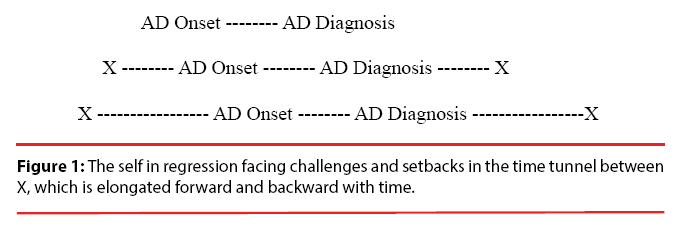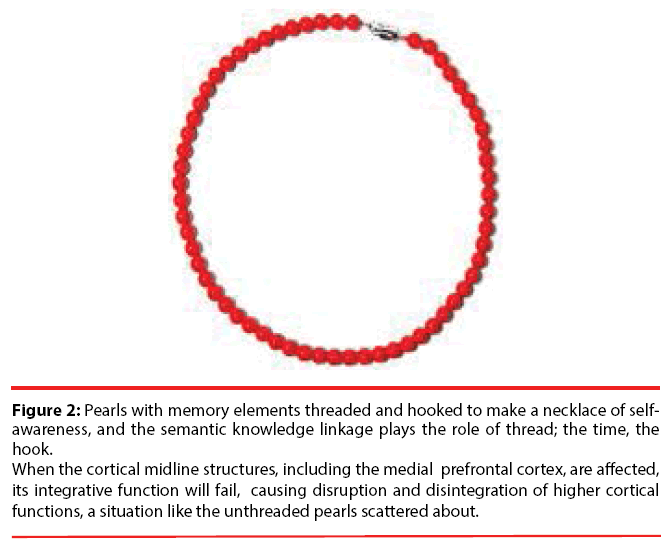Short Communication - Neuropsychiatry (2017) Volume 7, Issue 1
The key to understanding the behavioral and psychological symptoms of Alzheimers disease: pearls, string, hook, and the necklace
- Corresponding Author:
- Jin-Lieh Chan, M.D.
Department of Neurology
Yangming branch, Taipei City Hospital #105 Yu-Shen St
Shih-Lin, 111, Taipei, Taiwan
Tel: (02) 28389178
E-mail: [email protected]
Abstract
A person’s behavior is under the influence of his own past experiences and future life goals. Therefore, everyone has a reference framework of his own to interpret the daily world. Tulving called this type of autobiographical knowledge “autonoetic awareness,” which binds the past, present and possible future together and forms one’s behavior with continuous entity through time, like pearls with memory elements threaded and hooked to make a necklace of self-awareness, and the semantic knowledge linkage plays the role of thread; the time, the hook.
Keywords
Self-awareness, Ego, Alzheimer’s disease
Introduction
Nobel Prize winner Charles K. Kao’s wife, sharing her experience taking care of her husband with Alzheimer’s disease (AD) [1], said “People, facing the death of the family, feel mournful and reluctant to let go of the body dying out. My husband’s body is still there, but that familiar person and his soul are not. AD is a very insidious disease. It usually comes silently and insensibly. At one time, he took a tram in the opposite way, and did not know how to get back. He called me for help, which just made me feel something wrong.” The above description about AD is quite to the point. It comes insidiously. Early AD manifests forgetfulness and way-finding difficulty. Mid and late AD manifest getting lost, personality change, behavioral problems and dependent living. Such a disease, with so severe outcome, lasts about 10 years. It causes burdens and sufferings to the patients and caregivers. Although the etiology is obscure and no known treatment for cure is available, understanding the symptom mechanisms still benefits a lot to the family and caregivers.
Self-awareness and ego
“Who am I?” Such a silly question is the focus of AD in its course. From the connotation of “self ”, a person’s behavior is under the influence of his own past experiences and future life goals. Therefore, everyone has a reference framework of his own to interpret the daily world. Tulving [2] called this type of autobiographical knowledge “autonoetic awareness,” which binds the past, present and possible future together and forms one’s behavior with continuous entity through time, like pearls with memory elements threaded and hooked to make a necklace of self-awareness, and the semantic knowledge linkage plays the role of thread; the time, the hook. The ego (a sense of self ), by Freudian concept, [3] follows “reality principle [4]”. It is driven by the id of primitive drives, confined by the super-ego aiming for perfection, and repulsed by reality. Its main concern is with the individual’s safety. Selfawareness of AD is not updated with time from the beginning, and gradually breaks down, [5,6] causing malfunction of the “reality principle” of ego and loss of security, followed by gradual regression of behavior by the “pleasure principle [7] ” of id, and finally stepping into chronic confusional state [8] and social isolation.
Alzheimer’s disease
By Braak and Braak’s staging [9], the entorhinal cortex and hippocampus are firstly involved in AD, causing recent memory impairment (forgetfulness) and spatial disorientation (wayfinding difficulty). Forgetfulness is due to failure to register recent events, resulting in repeated questioning of the same thing without awareness of just having done so. Self-awareness is then not updated with time (Figure 1). Way-finding difficulty is due to cognitive map impairment, [10,11] resulting in path integration failure to guide the direction in familiar environments. In this stage, way-finding difficulty itself will not cause getting lost, because of the still presence of neocortical functions, such as spatial concept, language function, and self-awareness to ask for help. In later stages, neocortices will be involved, which are the locations of remote semantic memories (learned abilities, pearls in the brain), integrated by the cortical midline structures (CMSs), including the medial prefrontal cortex, [12] responsible for linking internal and external stimuli and integrating these stimuli in the emotional and autobiographical context of one’s own, a fundamental component in generating a model of the self. Breakdown of the self is the final outcome of AD.
Neocortical dysfunction syndrome
Following the involvement of entorhinal cortex and hippocampus, as AD goes on, neocortex will be gradually destroyed, causing neocortical dysfunction syndrome: aphasia, apraxia, agnosia, executive dysfunction, and impaired judgment and financial management, etc., like the pearls in the brain losing luster or getting damaged. When the CMSs are affected, its integrative function will fail, causing disruption and disintegration of higher cortical functions, a situation like the unthreaded pearls scattered about (Figure 2). At this time, the knowledge about the self is disrupted, residual and gradually devoid of content. Self-awareness is becoming an empty nothing, causing insecurity and threatening of survival of the body in its environment. How the “ego” will face the coming challenges and setbacks? (Figure 1).
Figure 2: Pearls with memory elements threaded and hooked to make a necklace of selfawareness, and the semantic knowledge linkage plays the role of thread; the time, the hook.
When the cortical midline structures, including the medial prefrontal cortex, are affected, its integrative function will fail, causing disruption and disintegration of higher cortical functions, a situation like the unthreaded pearls scattered about.
Behavioral and psychological symptoms of AD (BPSD)
Insecurity complex of the “ego” is the focus of AD throughout its course [5]. Repeated questioning the same thing without awareness opens the curtain to the time tunnel of anxiety. It yields stress when finding the way home becomes an issue. To insist on something being stolen (delusion of theft) is understandable, because it was placed (or hidden) somewhere without awareness (registration in the brain) by himself (or herself ).
When the neocortex breaks down, remote semantic memory (pearls in the brain) will be involved (pearls losing luster or damaged). The ego becomes unable to function as usual by the reality principle to secure itself. Regressive behaviors become apparent by the pleasure principle of id, e.g., oral tendency of infants (second infancy) [13]. The ego in regression gradually loses all the disciplines in life, causing disorders in daily living. Picking up and eating a piece of banana from a fruit stand in the market, while passing by, is regarded as a live evidence of stealing. When taken to the police department, not knowing what happened, the patient kept acclaiming the good taste of the banana [14]. Playing with own feces, though inconceivable, is considered regressive behavior, with impaired visual recognition and smell function [15] in AD. In moderate to severe AD, with self-awareness gradually devoid of content, wandering [16] and getting lost become manifest. Because the “self ” itself becomes empty, aimless wandering follows “pleasure principle” of id, causing herd behavior [17] and getting lost episodes. Patients found away from their residences and taken to the police department, usually respond irrelevantly to questions, do not know their names, family, residing places, etc. Unexceptionally they are quiet, looking dull, showing no expression in the eyes, and do not bring up any request voluntarily.
Regression of self-awareness lessens apprehensive expectation anxiety [18], but subsequent environmental stress-induced insecurity and fear follow. Behavioral mode then tends to be delusions (psychosis of fear) [19], e.g., delusion of persecution, theft, jealousy, being betrayed, deserted, etc.
Principles of management of BPSD
Management of BPSD is a key component of a comprehensive approach to the treatment of AD, which includes two aspects: pharmacological and non-pharmacological interventions. Non-pharmacological interventions are looking for reasons, such as environmental or physiological stress factors, causing the patients in a state of insecurity. Trying to find out such stress factors, e.g., external threats, internal fears, or bodily discomforts, to decrease his insecurity complex is top priority. Do not correct mistakes or force to participate in activities to add on stress. Trying to guide misbehaviors, shift attention from fixed ideas, and offer proper foods and music are keys to calm and peace. In some AD patients, their BPSD are relatively mild. This is because love and care from the family and environments offer them a sense of security, a sense away from fear, even though they may have an indistinct thinking that they are not like the ones before.
Conclusion
Pearls are scattered about, and reducing in number. To cherish the memory of the past is impossible in late AD. The essence of “killing time” in daycare home is not reminiscence [20], but to offer common thread linking the past and present, e.g., festivals, or non-thread activities, e.g., taking a walk, chatting, playing mahjong, singing, exercising etc. Like back in childhood, parents taking care of us, we nurture them back for return.
References
- Nobel Prize winner Charles K Kao’s wife sharing experience taking care of her husband with Alzheimer’s disease. Liberty Times, Taiwan (2010).
- Tulving E. Episodic memory: from mind to brain. Annu. Rev. Psychol 53(1), 1-25 (2002).
- Id, ego and super-ego.
- Reality principle.
- Chan JL. Progressive regression and impaired updating of self-knowledge help explain behavioral and psychological symptoms of Alzheimer’s disease (in Chinese). Taiwan. Ger. Gerontol 5(3), 1829 (2010).
- Chan JL, Lin CY, Lee CF, et al. Insight and self-awareness in patients with Alzheimer’s disease. Taipei. City. Med. J 11(3), 231-235 (2014).
- Pleasure principle.
- Jihui G, Linhua W, Yingying L, et al. NANDA-I Nursing Diagnosis Manual (translated in Chinese) Huaxing Press, 137-138 (2009).
- Braak H, Braak E. Neuropathological staging of Alzheimer-related changes. Acta. Neuropathol 82(1), 239-259 (1991).
- O’Keefe J, Nadel L. The Hippocampus as a Cognitive Map. Oxford University Press (1978).
- Cognitive map.
- Borthoff G, Bermpohl F. Cortical midline structures and the self. Trends. Cogn. Sci 8(3), 102-107 (2004).
- Reisberg B. Functionl assessment staging (FAST). Psychopharmacol. Bull 24(1), 653-659 (1988).
- Stealing a piece of banana. Liberty Times, Taiwan (2010).
- Alves J, Petrosyan A, Magalhaes. Olfactory dysfunction in dementia. World. J. Clin. Cases 2(11), 661 667 (2014).
- Lai CK, Arthur DG. Wandering behavior in people with dementia [Review]. J. Adv. Nurs 44(1), 173-182 (2003).
- Herd behavior.
- Anxiety.
- Ohman A. Fear and anxiety: Evolutionary, cognitive, and clinical perspectives. The Guilford Press, New York, 573 (2000).
- Woods B, Spector A, Jones C, et al. Reminiscence therapy for dementia. Cochrane. Database. Syst. Rev (2), CD001120 (2005).

